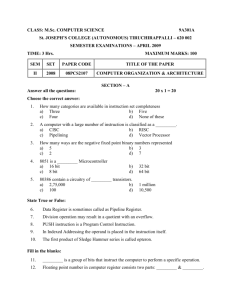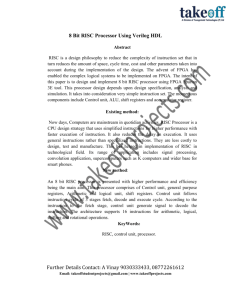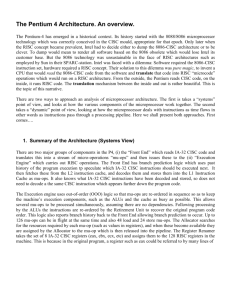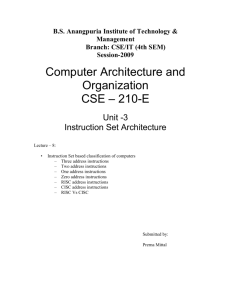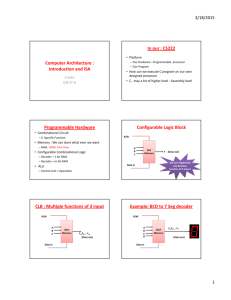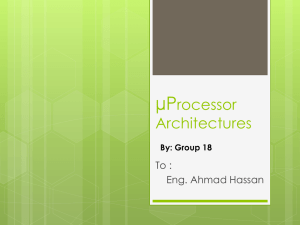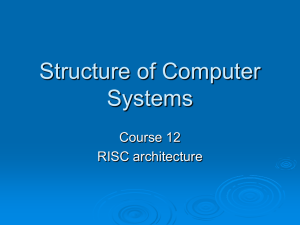CISC, RISC and Post RISC - Department of Computer Science
advertisement
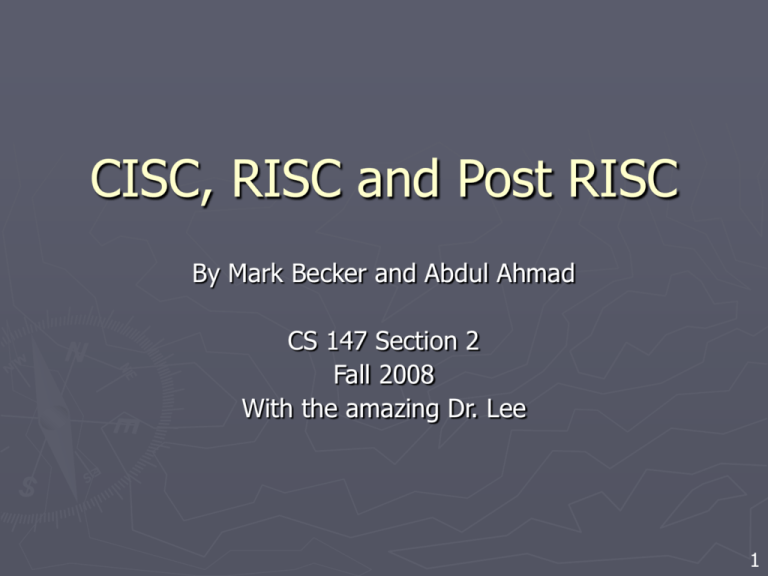
CISC, RISC and Post RISC By Mark Becker and Abdul Ahmad CS 147 Section 2 Fall 2008 With the amazing Dr. Lee 1 CISC, RISC and Post RISC By Mark Becker and Abdul Ahmad CISC Complex Instruction Set Computers (CISC): 2 CISC, RISC and Post RISC By Mark Becker and Abdul Ahmad CISC Definition: A complex instruction set computer (CISC, pronounced like "sisk") is a microprocessor instruction set architecture (ISA) in which each instruction can execute several low-level operations, such as a load from memory, an arithmetic operation, and a memory store, all in a single instruction. The term was retroactively coined in contrast to reduced instruction set computer (RISC). 3 CISC, RISC and Post RISC By Mark Becker and Abdul Ahmad CISC History: In the late 1950s, faced with the need to rationalize it's computer product lines, IBM instituted a research program having the objective of creating a range of software compatible computers that would also capture its existing software investments. The result, introduced on April 7, 1964 was the System/360, the first commercially available microprogrammed computer architecture (latter to become known as complex instruction set computer, or CISC architecture). The success of System/360 resulted in CISC architectures dominating computer, and later microprocessor, design for two decades. 4 CISC, RISC and Post RISC By Mark Becker and Abdul Ahmad CISC History (cont): However, the ability to incorporate any instruction which could be microprogrammed turned out to be a mixed blessing. During the mid-1970s, improved performance measurement tools demonstrated that the execution of most application programs on CISC-based systems was dominated by a few simple instructions, and the complex ones were seldom used. 5 CISC, RISC and Post RISC By Mark Becker and Abdul Ahmad CISC History (cont): As a result, in October 1975 the project was initiated at IBM's Watson Research Center which, four years later gave birth to a 32-bit RISC microprocessor named for the building in which it was developed. In the immortal words of Joel Birnbaum, the first leader of the 801 project and later designer of the PA-RISC architecture: “Engineers had guessed that computers needed numerous complex instructions in order to work efficiently. It was a bad guess. That kind of design produced machines that were not only ornate, but baroque - even rococo.” 6 CISC, RISC and Post RISC By Mark Becker and Abdul Ahmad CISC Clock Cycle Clock Cycle CISC instruction (compact and complex) CISC instruction (compact and complex) Main Memory Hardware Hardware Benefits: •Directly supported high-level programming constructs combined into single instructions. •The compact nature of such instruction sets resulted in smaller program sizes and fewer calls to main memory which meant good programming productivity. •Many designs achieved the aim of higher throughput at lower cost and also allowed high-level language constructs to be expressed by fewer instructions. 7 CISC, RISC and Post RISC By Mark Becker and Abdul Ahmad CISC Clock Cycle Clock Cycle Clock Cycle Unused Pipeline Unused Pipeline Unused Pipeline Unused Pipeline Unused Pipeline Unused Pipeline CISC instruction Main Memory CISC instruction Hardware Hardware Problems: •Low-end versions of complex architectures (i.e. using less hardware) could lead to situations where it was possible to improve performance by not using a complex instruction (such as a procedure call or enter instruction), but instead using a sequence of simpler instructions. •The invention of Pipelining made CISC less efficient because the CISC instruction could not be broken up into smaller parts that could be run simultaneously. •When memory became less expensive, it became less important to create instruction sets that called main memory fewer times. 8 CISC, RISC and Post RISC By Mark Becker and Abdul Ahmad RISC Reduced Instruction Set Computers (RISC): 9 CISC, RISC and Post RISC By Mark Becker and Abdul Ahmad RISC The Microprocessor •Revolution Technology in microprocessor has led to new inventions, such as digital devices such as digital camera, wristwatches, cellular phone, personal computers and non digital device such as automobile are more intelligent. Their performance has improved by a factor of 10,000 in the 37 years since its birth in 1971! Has any other invention, so useful already at birth, undergone a similar improvement? •As we already know that the development of microprocessor has been doubling every 18 month! •This increase partly was influenced with the introduction of Reduced Instruction Set Computers (RISC). The instruction set is the hardware "language" in which the software tells the processor what to do. Surprisingly, reducing the size of the instruction set -- eliminating certain instructions based upon a careful quantitative analysis, and requiring these seldom-used instructions to be emulated in software -can lead to higher performance, for several reasons: 10 CISC, RISC and Post RISC By Mark Becker and Abdul Ahmad RISC The Microprocessor (continued) •Performance can be accelerated since there are more space in the chip with commonly used instruction. •Optimization is easier. •It allows microprocessors to use techniques that was restricted to the largest computers. •It simplifies translation from the high-level language in which people program into the instruction set that the hardware understands, resulting in a more efficient program. •RISC creation was preceded the hardware design, a more quantitative approach to computer architecture. Previously, many computer design projects guided by intuition that lead to disappointing results. 11 CISC, RISC and Post RISC By Mark Becker and Abdul Ahmad RISC The History of RISC •Three research project conducted by IBM, the Berkeley RISC processor, and the Stanford MIPS processor contributed in RISC early development. •It attracted enormous interest because of claims of a performance advantage of anywhere from two to five times. •IBM project was the first to start in the late 70’s but was the last to become public. The IBM machine was designed as a minicomputer made from hundreds of chips, while the university projects were both microprocessors. •John Cocke is considered to be the father of the 801 design. In recognition of his contribution he received both the Turing award, the highest award in computer science and engineering, and the Presidential Medal of Technology. 12 CISC, RISC and Post RISC By Mark Becker and Abdul Ahmad RISC The History of RISC •In 1980, David A. Patterson and his colleagues at the University of California at Berkeley, sponsored by the Department of Defense Advanced Research Projects Agency(DARPA), began the project that was to give this approach its name. They built two machines, called RISC-I and RISC-II. Because the IBM project was not widely known or discussed, the role played by the Berkeley group in promoting the RISC approach was critical to the acceptance of the technology. •In 1981, John L. Hennessy and his colleagues at Stanford published a description of the Stanford MIPS machine, also developed under DARPA sponsorship. Both university projects were interested in designing a simple machine that could be built as a microchip within the university environment. All three early RISC machines had similar "reduced" languages. 13 CISC, RISC and Post RISC By Mark Becker and Abdul Ahmad RISC The History of RISC •Importantly, the Berkeley and Stanford projects fit within the DARPA VLSI Program that developed the concept of the multichip wafer, which allowed multiple integrated circuit designs to share a single silicon fabrication run, dramatically reducing costs. •In 1986 the computer industry began to announce commercial processors based on the technology explored by the three RISC research projects. •In 1987 Sun Microsystems began delivering machines based on the SPARC architecture, a derivative of the Berkeley RISC-II machine. It was Sun's success with RISC-based workstations that convinced the remaining skeptics that RISC was significant commercially. In particular, RISC advocates used Sun's success to get RISC restarted at IBM. IBM announced a new RISC architecture in 1990. 14 CISC, RISC and Post RISC By Mark Becker and Abdul Ahmad RISC The History of RISC •Intel's microprocessors are used in the popular IBM PC, and hence are the most widely used microprocessors, but they predate RISC. RISC microprocessors have been the standard-bearers of performance, so Intel has embraced ideas from RISC and followed the quantitative approach. Thus both the ideas and the competition from RISC has benefited all computer users, since RISC has raised the performance target for the entire industry. With the announcement that Hewlett-Packard and Intel will move to a common instruction set in 1997, the end of the non-RISC architectures draws near. 15 CISC, RISC and Post RISC By Mark Becker and Abdul Ahmad RISC Pipeline Clock Cycle Clock Cycle RISC instruction RISC instruction Main Memory RISC instruction Hardware RISC instruction Hardware RISC instruction RISC instr Advantages: •Can run several instructions simultaneously •Shorter Instructions - Breaking the complex instruction into several short simpler instructions •Minimize latency effect between instructions •Multiple hardware pieces can interact in one clock cycle 16 CISC, RISC and Post RISC By Mark Becker and Abdul Ahmad RISC How much faster is RISC than CISC? Today's microprocessors are roughly 10,000 times faster and cost only 1/40th as much as their ancestors. The result: This extraordinary advance is why computing plays such a large role in today's world. Had the research at universities and industrial laboratories not occurred -- had the complex interplay between government, industry, and academia not been so successful - a comparable advance would still be years away. Microprocessor performance can continue to double every 18 months beyond the turn of the century. This rate can be sustained by continued research innovation. Significant new ideas will be needed in the next decade to continue the pace; such ideas are being developed by research groups today. 17 CISC, RISC and Post RISC By Mark Becker and Abdul Ahmad Post RISC Introduction: The current generation of processors introduces an exciting new era of high performance processors. These processors uniformly show dramatic increases in performance of a scale that has not been seen since the late 1980s when RISC processors first became available. The changes that spurred the performance gains of RISC were clear because they were changes in instruction set architecture (ISA). The changes that are spurring the performance gains of recent processors, however, are more subtle. While there are some changes that impact the ISA such as the Intel MMX and Sun VIS instructions, the performance gains are mostly due to features that are decidedly not RISC. These new features referred as Post-RISC. 18 CISC, RISC and Post RISC By Mark Becker and Abdul Ahmad Post RISC Post-RISC Characteristics: The most significant PostRISC changes are to the implementation of the architecture. Superscalar RISC processors relied on the compiler to order instructions for maximum performance and hardware checked the legality of multiple simultaneous instruction issue. 19 CISC, RISC and Post RISC By Mark Becker and Abdul Ahmad Post RISC Post-RISC Characteristics: Post-RISC processors are much more aggressive at issuing instructions using hardware to dynamically perform the instruction reordering. The new processors find more parallelism by executing instructions out of program order. 20 CISC, RISC and Post RISC By Mark Becker and Abdul Ahmad Post RISC Post-RISC Characteristics: Out-of-order execution is not a new concept in computing (it existed twenty years ago on IBM and CDC computers) but it is innovative for single-chip implementations. The result is a RISC ISA with an execution core that is similar to a dataflow implementation. However, these processors still adhere to most of the RISC concepts. For example, the execution units of these processors are optimized to complete most instructions in a single cycle. 21 CISC, RISC and Post RISC By Mark Becker and Abdul Ahmad Post RISC Post-RISC Pipeline: The Post-RISC Pipeline consists of three connected three connected components: (1) Fetch/Decode section, (2) Execution Units, and (3) Retire Units. Between each of these components, there is a flexible queue of instructions. The Instruction Reorder Buffer connects the Fetch/Decode components and the Execution Units. The Completed Instruction Buffer connects the Execution units to the Retire Unit. 22 CISC, RISC and Post RISC By Mark Becker and Abdul Ahmad Post RISC Conclusion: The architectures of modern processors are moving toward a fundamental change in approach that we have called the Post-RISC architecture. In order to utilize increasing numbers of high-speed functional units, the processors must optimize instruction schedules at run-time. Dynamic, out-of-order scheduling is a promising technique to keep functional units busy and it is being used in many new processors. These Post-RISC processors reduce the growing disparity between processor and memory speeds. The combination of rescheduled instructions with buffered loads and stores allows some memory latency to be hidden. However, the fundamental problem of growing memory latency with respect to processor speed remains. 23 CISC, RISC and Post RISC By Mark Becker and Abdul Ahmad References Wikipedia - Complex instruction set computer http://en.wikipedia.org/wiki/Complex_instruction_set_computer A Brief History of RISC (circa 2001) http://www.aallison.com/history.htm Reduced Instruction Set Computers (RISC): Academic/Industrial Interplay Drives Computer Performance Forward http://www.cs.washington.edu/homes/lazowska/cra/risc.html Beyond RISC - The Post-RISC Architecture http://www.cse.msu.edu/~enbody/postrisc/postrisc2.htm Computer Architecture and Organization: An Integrated Approach By Miles J. Murdocca and Vincent P. Heuring ISBN: 978-0-471-73388-1 http://www.wiley.com/WileyCDA/WileyTitle/productCd-0471733881.html 24

